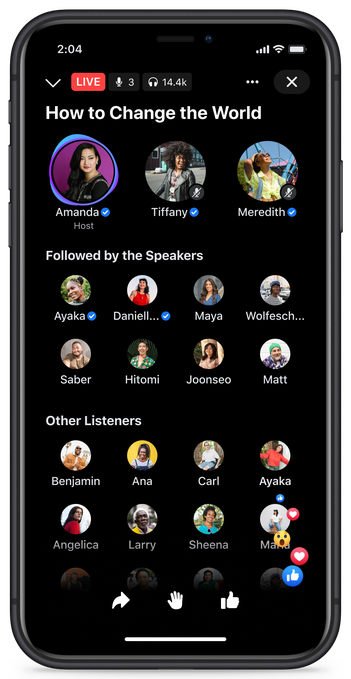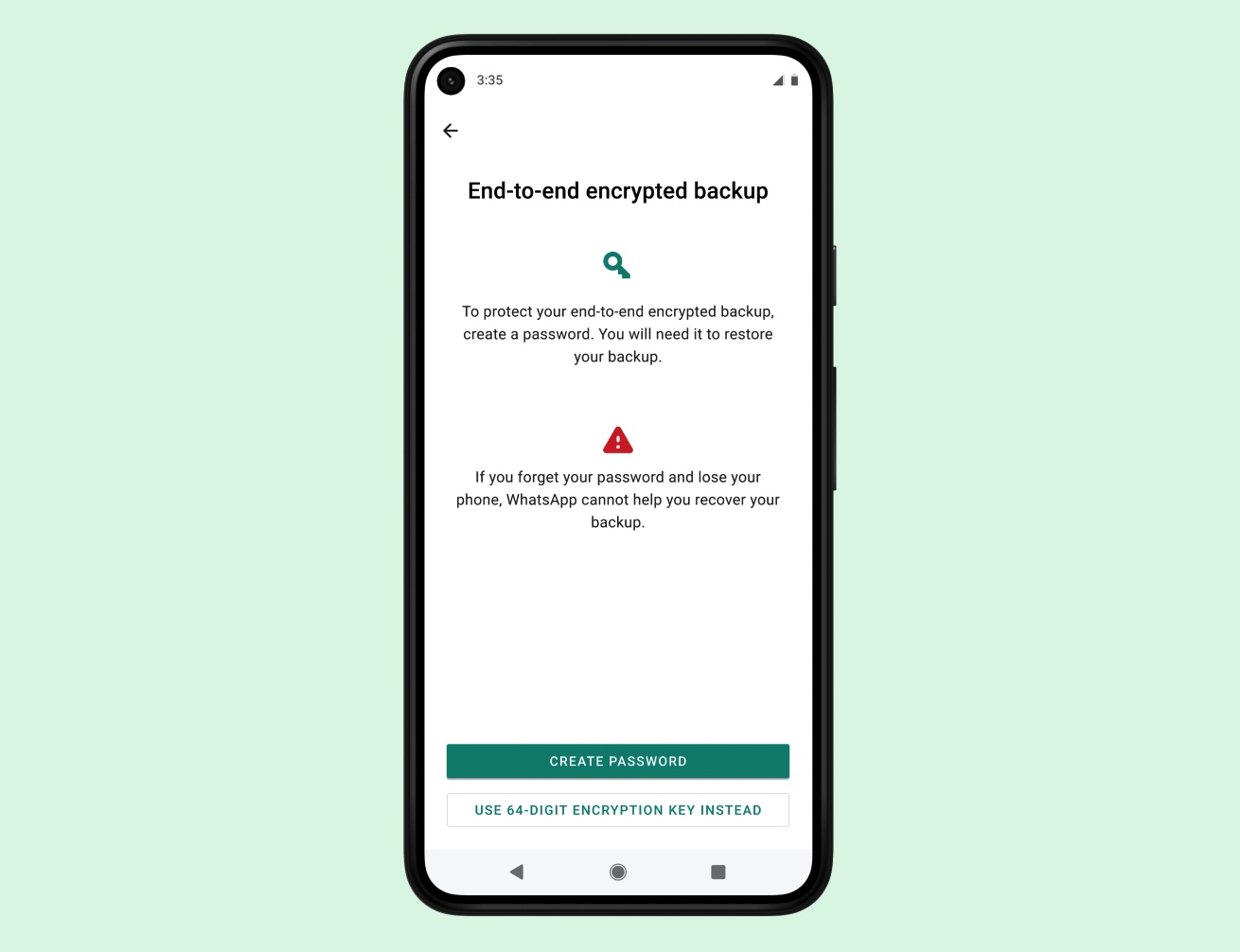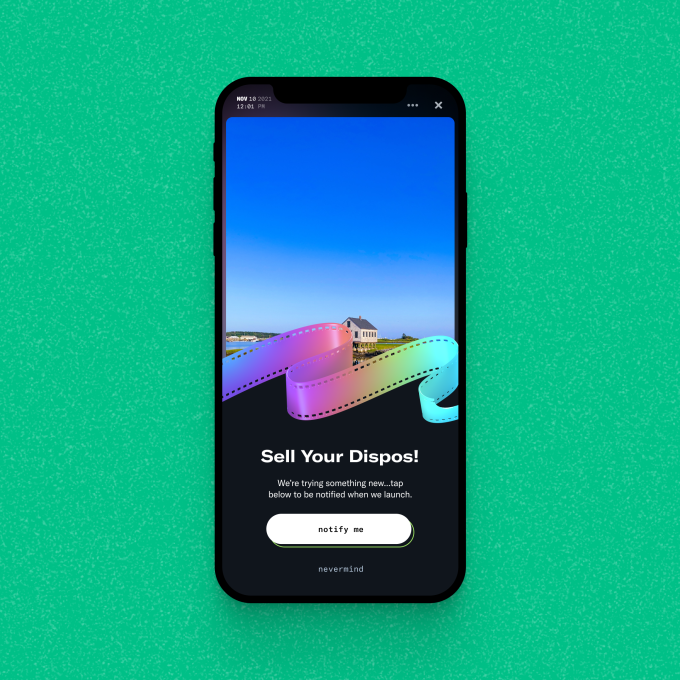APPS
Facebook officially launches Live Audio Rooms and podcasts in the US

In April, Facebook announced a series of planned investments in new audio products, including a Clubhouse live audio competitor as well as new support for podcasts. Today, Facebook is officially rolling these products with the launch of Live Audio Rooms in the U.S. on iOS, starting with public figures and select Facebook Groups, and the debut of an initial set of U.S. podcast partners.
The company tells us Live Audio Rooms will become available to any verified public figure or creator in the U.S. who’s in good standing with Facebook and is using either a profile or the new Facebook Pages experience on iOS. For Facebook Groups, the feature is launching with “dozens of groups,” we’re told.
Both products will become more broadly available in the weeks and months ahead, as more people, podcasts, and Groups are brought on board. Meanwhile, 100% of Facebook users in the U.S. will be able to listen to Live Audio Rooms and podcasts as of this week.

Image Credits: Facebook
Much like Clubhouse or similar audio apps, Facebook’s Live Audio Rooms offer a standard set of features.
The event’s hosts appear in rounded profile icons at the top of the screen, while the listeners appear in the bottom half of the screen, as smaller icons. The active speaker is indicated with a glowing ring. If verified, a check appears next to their name, as well.
There are also options for enabling live captions, a “raise hand” tool to request to speak, and tools to share the room with others on Facebook, through things like News Feed or Group posts.

Image Credits: Facebook
Facebook does things a little differently than others in some places. For instance, hosts are able to invite people to join them as a speaker in advance of the session, or they can choose listeners during the stream to join them. In each session, there can be up to 50 speakers and there’s no limit on the number of listeners, Facebook says.
During the session, users will be notified when friends or followers join the chat, too.
While listening, users can “Like” or react to the content as it streams using the “Thumbs Up” button at the bottom of the screen which connects you to Facebook’s set of emoji reactions. And with today’s official launch, listeners can also now show support to the public figure of the Live Audio Room by sending “Stars.” These Stars can be purchased during the conversation and used at any time, similar to how they work with other Facebook Live content.
By sending Stars, the listener is bumped up to the “Front Row,” a special section that highlights the people who sent the Stars. This allows the event’s hosts to easily recognize their supporters and even give them a shout out during the event, if they choose.

Image Credits: Facebook
Another new feature allows hosts to select a nonprofit or fundraiser to support during their conversation, and listeners and speakers can directly donate. A progress bar will show how much has been raised during the show.

Image Credits: Facebook
Meanwhile, for Facebook Groups, admins can control whether moderators, group members or other admins can create a Live Audio Room. Both members and visitors can listen to the rooms in public groups, but in private groups, the rooms are limited to Group members.
Facebook users are alerted to all the new Live Audio Rooms via the News Feed and Notifications, and can sign up to be reminded when a room they’re interested in goes Live. Live Audio Rooms will also be discoverable within Facebook Groups, where available.

Image Credits: Facebook
Among the initial set of early adopters for Facebook Live Audio Rooms are Grammy-nominated electronic music artist TOKiMONSTA; American football quarterback Russell Wilson; organizer, producer and independent journalist Rosa Clemente; streamer and digital entertainer Omareloff; and social entrepreneur Amanda Nguyen. Others planned for the near future include D Smoke, Kehlani, Reggie Watts, and Lisa Morales Duke, to Dr. Jess, Bobby Berk, Tina Knowles-Lawson, Joe Budden (notably Spotify’s first big podcast star who it lost last year), and DeRay Mckesson.

Image Credits: Facebook
Facebook Groups trying the new format include Dance Accepts Everyone, Vegan Soul Food, Meditation Matters, Pow Wow Nation, OctoNation – The Largest Octopus Fan Club!, and Space Hipsters.

Image Credits: Facebook
Alongside the launch of Live Audio Rooms, Facebook is also beginning to roll out its planned podcast support with a few select creators. These include Joe Budden of The Joe Budden Podcast; “Jess Hilarious” of Carefully Reckless from The Black Effect Podcast Network and iHeartRadio; Keltie Knight, Becca Tobin, and Jac Vanek of The LadyGang; and Nicaila Matthews Okome of Side Hustle Pro. Facebook will open up to other podcasters this summer.

Image Credits: Facebook
To be clear, this new podcasts service is different from the recently launched music and podcasts player in partnership with Spotify, which lets users share content from Spotify to the social network. The new feature instead involves podcasts that are streamed via public RSS feeds directly on Facebook, not delivered by Spotify. However, the miniplayer for podcasts on Facebook will look like the miniplayer for the Spotify listening integration (also known as Project Boombox), and they will behave similarly. But they are not the same.
The new podcast listening experience lets users listen to podcasts as they browse Facebook, either in a miniplayer or fullscreen player with playback options, and even if the phone’s display is turned off. This makes Facebook, in a way, a native podcast streaming app because it allows people to listen to audio without needing another service — like Spotify or Apple Podcasts, for example.
Facebook had earlier said there are over 170 Facebook users who are connected to a Page for a podcast, demonstrating user interest in podcasts on its social network.

Image Credits: Facebook
With the launch of the Facebook Podcast service, the company is asking podcast creators to give it permission to cache their content on Facebook’s servers, which we’re told is being done to ensure the content doesn’t violate Facebook’s Community Standards. However, because the podcasts are still being streamed via RSS feeds, they will be represented in the metrics provided by a podcaster’s hosting provider.
Last week, Facebook emailed podcast page owners details on how to set up their show on Facebook, noting they can link their podcast’s RSS feed to automatically generate News Feed posts for their episodes. These are also featured on a “podcasts” tab on their Page. According to Facebook’s Podcast Terms of Service, creators are granting Facebook the right to create “derivative works,” which likely refers to an upcoming clips feature.
Facebook says later this summer, it will add the ability to create and share short clips from a podcast, along with other features, like captions. Longer-term, it will create social experiences around podcasts, as well. It’s also working with creators to develop and launch its new product, Soundbites, which are short-form, creative audio clips. This will launch later in 2021.

Image Credits: Facebook
Other audio products in the works include a central listening destination and background audio listening for videos.
Facebook says this new destination will be a place where all the different audio formats across Facebook are available, not just podcasts, and will help users find to new things and people to listen to. More details on this project will become available later this summer.
Prior to today, Facebook quietly tested Live Audio Rooms in Taiwan and internally with Facebook employees Those tests will continue. Last week, Facebook CEO Mark Zuckerberg hosted the first trial of the new service in the U.S., where he was joined by other Facebook execs and a few Facebook Gaming creators.
Zuckerberg has been bullish on the potential for audio across the social networking platform. He even appeared on Clubhouse a couple of times to discuss the topic ahead of announcing what is, essentially, Facebook’s own Clubhouse competitor.
“I think the areas where I’m most excited about it on Facebook are basically in the large number of communities and groups that exist,” Zuckerberg had told Platformer, at the time of the original announcement. “I think that you already have these communities that are organized around interests, and allowing people to come together and have rooms where they can talk is — I think it’d be a very useful thing,” he added.
Facebook expects to expand its audio products globally in the months ahead.
APPS
Best ASO Tips To Boost Your App Search In 2022

You need your application to be really effective in the overpopulated application market. Then, at that point, you will have to drive downloads to endure. So when it’s all said and done, you must account for yourself. Get your application the consideration it merits.
The uplifting news, however, is that customers love to download applications – last year, we downloaded in excess of 200 billion applications around the world, and that figure is set to increment to 258 billion every year by 2022 as cell phone reception increments.
Assuming you need to be seen and have your application downloaded by however many clients as could reasonably be expected, then, at that point, you should begin by taking a gander at the application store.
Underneath, we’ve assembled probably the best application store improvement methods to assist you with creating more downloads in 2021 and then some…
Start with Your Application Name
The odds are you as of now have an extraordinary name for your application, yet an appropriately advanced application is about significantly more than marking.
Assuming you need to amplify transparency and guarantee you’re showing up when clients look for applications like yours, you ought to remember the primary keywords for your application name or title, comparable to how you’d make a title label while improving a site page.
You could begin with your application name so it tends to be plainly recognized, thus it appears on the home screen of gadgets.
Then, at that point, you can add a scramble or vertical bar prior to adding a few pertinent watchwords to your speciality, or even put your application name in quotes as we did with FORE Business Golf Networking.
Urge Users to Leave Reviews
You could ask for reviews by clients through the means of your site, or through an in-application notice toward the finish of their meeting, yet make sure to restrict the number of pop-ups you execute with the goal that you don’t disturb or disappoint your clients, as this could urge them to erase your application.
We’d support all application engineers and entrepreneurs to react to criticism on their applications, as this can further develop client relations and resolve issues in an open arena.
Zero in on Your Application Depiction
Your application depiction is your principle assemblage of text your landing page content, in a manner of speaking. Utilize a site like KeywordTool.io to discover information on your picked catchphrases to expand your openness. As portrayals are shortened, ensure you remember the main data for the initial three lines of your depiction, and afterwards add things like social confirmation, emoticon, and suggestions to take action to build commitment and downloads.
Incorporate Appealings Screen Captures
Pictures and recordings won’t help your application rank, yet they will expand changes and assist clients with working out whether it’s an application they truly need.
There’s a little guide in empowering clients toward downloading your application if in any case, they’re not going to interface with it, or download and leave a negative survey when they understand it wasn’t what was promoted.
Assuming you need to ‘tart up’ your item page, then, at that point, you can add marking and extra text and data and designs to your recordings and screen capture, yet they ought not to diminish your item.
Pay for App Store or Play Store
As we have SEO and pay-per-click, you need to work one next to the other (one is a gradual methodology with long haul benefits – the other is a speedy success yet requires an endless spending plan), application store promotions can be utilized to get the message out with regards to your new programming and assist you with positioning at the highest point of query items pages – in front of your opposition and enormous names in the application world.
Keep in mind, you’ll need to focus on the right crowd and art an advertisement that will assist you with changing over and that since you’re paying for situations, that doesn’t mean clients will download or cooperate with your application.
Wrapping Up!
You can employ a group of App Store Optimization Services suppliers to benefit a scope of application store improvement administrations, including watchword advancement, resource enhancement, and restriction to guarantee your application is seen by individuals that matter.
We have long periods of involvement in creating and showcasing applications and have assisted different customers with expanding their downloads by infiltrating rewarding and regularly undiscovered business sectors.
Author:
Prachi Gupta likes to write information about Digital Marketing Trends that can help audience to grow their business.
APPS
WhatsApp will finally let users encrypt their chat backups in the cloud

WhatsApp said on Friday it will give its two billion users the option to encrypt their chat backups to the cloud, taking a significant step to put a lid on one of the tricky ways private communication between individuals on the app can be compromised.
The Facebook-owned service has end-to-end encrypted chats between users for more than a decade. But users have had no option but to store their chat backup to their cloud — iCloud on iPhones and Google Drive on Android — in an unencrypted format.
Tapping these unencrypted WhatsApp chat backups on Google and Apple servers is one of the widely known ways law enforcement agencies across the globe have for years been able to access WhatsApp chats of suspect individuals.
Now WhatsApp says it is patching this weak link in the system.
“WhatsApp is the first global messaging service at this scale to offer end-to-end encrypted messaging and backups, and getting there was a really hard technical challenge that required an entirely new framework for key storage and cloud storage across operating systems,” said Facebook’s chief executive Mark Zuckerberg in a post announcing the new feature.
Store your own encryption keys
The company said it has devised a system to enable WhatsApp users on Android and iOS to lock their chat backups with encryption keys. WhatsApp says it will offer users two ways to encrypt their cloud backups, and the feature is optional.
In the “coming weeks,” users on WhatsApp will see an option to generate a 64-digit encryption key to lock their chat backups in the cloud. Users can store the encryption key offline or in a password manager of their choice, or they can create a password that backs up their encryption key in a cloud-based “backup key vault” that WhatsApp has developed. The cloud-stored encryption key can’t be used without the user’s password, which isn’t known by WhatsApp.

Image Credits: WhatsApp/supplied
“We know that some will prefer the 64-digit encryption key whereas others want something they can easily remember, so we will be including both options. Once a user sets their backup password, it is not known to us. They can reset it on their original device if they forget it,” WhatsApp said.
“For the 64-digit key, we will notify users multiple times when they sign up for end-to-end encrypted backups that if they lose their 64-digit key, we will not be able to restore their backup and that they should write it down. Before the setup is complete, we’ll ask users to affirm that they’ve saved their password or 64-digit encryption key.”
A WhatsApp spokesperson told TechCrunch that once an encrypted backup is created, previous copies of the backup will be deleted. “This will happen automatically and there is no action that a user will need to take,” the spokesperson added.
Potential regulatory pushback?
The move to introduce this added layer of privacy is significant and one that could have far-reaching implications.
End-to-end encryption remains a thorny topic of discussion as governments continue to lobby for backdoors. Apple was reportedly pressured to not add encryption to iCloud Backups after the FBI complained, and while Google has offered users the ability to encrypt their data stored in Google Drive, the company allegedly didn’t tell governments before it rolled out the feature.
When asked by TechCrunch whether WhatsApp, or its parent firm Facebook, had consulted with government bodies — or if it had received their support — during the development process of this feature, the company declined to discuss any such conversations.
“People’s messages are deeply personal and as we live more of our lives online, we believe companies should enhance the security they provide their users. By releasing this feature, we are providing our users with the option to add this additional layer of security for their backups if they’d like to, and we’re excited to give our users a meaningful advancement in the safety of their personal messages,” the company told TechCrunch.
WhatsApp also confirmed that it will be rolling out this optional feature in every market where its app is operational. It’s not uncommon for companies to withhold privacy features for legal and regulatory reasons. Apple’s upcoming encrypted browsing feature, for instance, won’t be made available to users in certain authoritarian regimes, such as China, Belarus, Egypt, Kazakhstan, Saudi Arabia, Turkmenistan, Uganda and the Philippines.
At any rate, Friday’s announcement comes days after ProPublica reported that private end-to-end encrypted conversations between two users can be read by human contractors when messages are reported by users.
“Making backups fully encrypted is really hard and it’s particularly hard to make it reliable and simple enough for people to use. No other messaging service at this scale has done this and provided this level of security for people’s messages,” Uzma Barlaskar, product lead for privacy at WhatsApp, told TechCrunch.
“We’ve been working on this problem for many years, and to build this, we had to develop an entirely new framework for key storage and cloud storage that can be used across the world’s largest operating systems and that took time.”
APPS
Dispo launches a test to gauge user interest in selling their photos as NFTs

Dispo, the photo-sharing app that emulates disposable cameras, started rolling out a test yesterday that will record user interest in selling photos as NFTs. Some users will now see a sell button on their photos, and when they tap it, they can sign up to be notified when the ability to sell Dispo photos launches.
CEO and co-founder Daniel Liss told TechCrunch that Dispo is still deciding how it will incorporate NFT sales into the app, which is why the platform is piloting a test with its users. Dispo doesn’t know yet what blockchain it would use, if it would partner with an NFT marketplace or what cut of sales Dispo would take.
“I think it’s safe to say from the test that there will be an experience native to the Dispo app,” Liss said. “There are a number of ways it could look — there could be a native experience within Dispo that then connects through an API to another platform, and in turn, they’re our partner, but to the community, it would look native to the Dispo app.”

Image Credits: Dispo
This marks a new direction for the social media app, which seeks to redefine the photo-sharing experience by only letting users see the photos they took at 9 AM the next morning. From Dispo’s perspective, this gimmick helps users share more authentically, since you take one photo and then you’re done — the app isn’t conducive to taking dozens of selfies and posting the “best” image of yourself. But though it only launched in December 2019, Dispo has already faced both buzzy hype and devastating controversy.
Until about a year ago, the app was called David’s Disposables, named after co-founder and YouTuber David Dobrik. The app was downloaded over a million times in the first week after its release and hit No. 1 on the App Store charts. In March 2021, the app dropped its waitlist and relaunched with social network features, but just weeks later, Insider reported sexual assault allegations against a member of Vlog Squad, Dobrik’s YouTube prank ensemble. In response, Spark Capital severed ties with the company, leading to Dobrik’s departure. Other investors like Seven Seven Six and Unshackled Ventures, which contributed to the company’s $20 million Series A round, announced that they would donate any profits from their investments in Dispo to organizations working with survivors of sexual assault.
Liss told TechCrunch in June, when the company confirmed its Series A, that Dobrik’s role with the company was as a marketing partner — Liss has been CEO since the beginning. In light of the controversy, Liss said the app focused on improving the product itself and took a step back from promotion.
According to data from the app analytics firm SensorTower, Dispo has reached an estimated 4.7 million global installs to date since launch. Though the app saw the most downloads in January 2020, when it was installed over 1 million times, the app’s next best month came in March 2021, when it removed its waitlist — that month, about 616,000 people downloaded Dispo. Between March and the end of August, the app was downloaded around 1.4 million times, which is up 118% year over year compared to the same time frame in 2020 — but it should be expected that this year’s numbers would be higher, since last year, the app’s membership was exclusive.

Image Credits: Dispo
Now, with the announcement that Dispo is pursuing NFTs, Liss hopes that his company won’t just change how people post photos, but what the relationship will be between platforms and the content that users create.
“Why NFTs? The most powerful memories of our lives have value. And they have economic value, because we created them, and the past of social media fails to recognize that,” Liss told TechCrunch. “As a result, the only way that a creator with a big following is compensated is by selling directly to a brand, as opposed to profiting from the content itself.”
Adding NFT sales to the app offers Dispo a way to profit from a cut of user sales, but it stands to question how adding NFT sales could impact the community-focused feel of Dispo.
“I think there is tremendous curiosity and interest,” Liss said. “But these problems and questions are why we need more data.”
-

 WORDPRESS6 days ago
WORDPRESS6 days agoTurkish startup ikas attracts $20M for its e-commerce platform designed for small businesses
-

 PPC7 days ago
PPC7 days agoA History of Google AdWords and Google Ads: Revolutionizing Digital Advertising & Marketing Since 2000
-

 MARKETING6 days ago
MARKETING6 days agoRoundel Media Studio: What to Expect From Target’s New Self-Service Platform
-
SEARCHENGINES5 days ago
Daily Search Forum Recap: April 12, 2024
-

 SEO5 days ago
SEO5 days agoGoogle Limits News Links In California Over Proposed ‘Link Tax’ Law
-

 MARKETING7 days ago
MARKETING7 days agoUnlocking the Power of AI Transcription for Enhanced Content Marketing Strategies
-

 SEARCHENGINES6 days ago
SEARCHENGINES6 days agoGoogle Search Results Can Be Harmful & Dangerous In Some Cases
-

 SEO4 days ago
SEO4 days ago10 Paid Search & PPC Planning Best Practices












